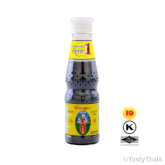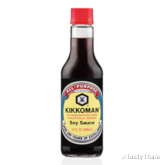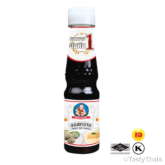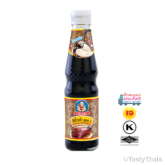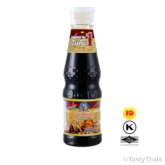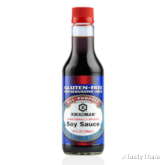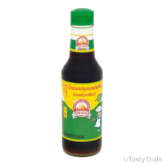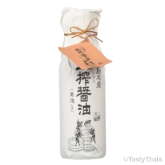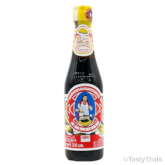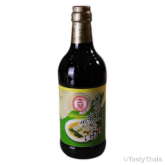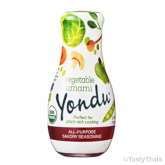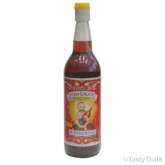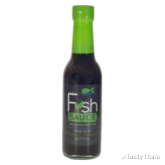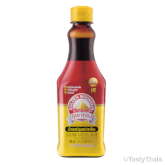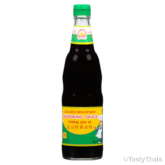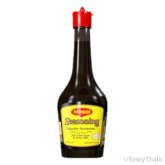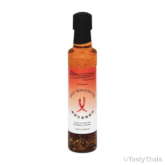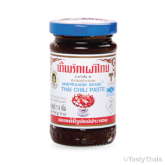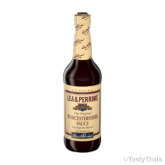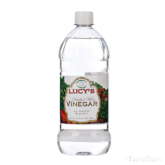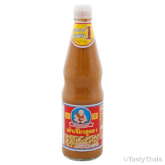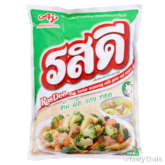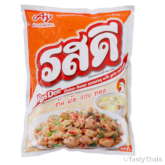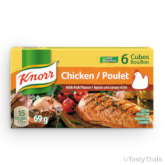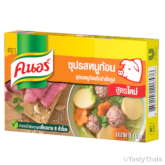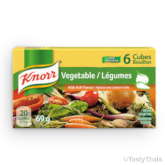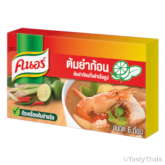There is a list of Thai seasonings used in cooking Thai food that is as long as your arm; recipes for homemade spice mixes and the like but that is not what this page is about.
In this article we look at the seasoning products that are used in multiple dishes everyday in Thai kitchens.
We have also separated out curry pastes and certain other ‘special Thai’ ingredients into a Special Thai Ingredients page so if you don’t find something here then pop over there for a look.
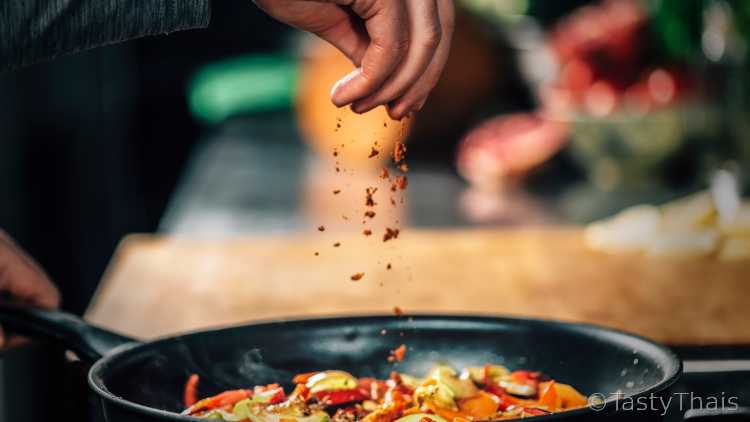
What is Seasoning?
Seasoning is a spice compounds or extracts of spices that are usually in liquid or powdered form and added to a dish to enhance flavor a little rather than introduce a substantial new flavor.
Salt, pepper & sugar and a number of special spice mixes for specific dishes are seasonings but here we are looking more at the seasonings that are used across a wide number of Thai recipes rather than individually specific seasonings.
Most of the seasonings that you will see in the Table below are quite commonly used.
Be aware though that most seasonings contain quite high levels of salt which is thought to cause high blood pressure. If you can find low sodium versions they’ll help but otherwise just be aware of the salt in the seasoning you are adding.
Table of Thai Seasonings
Notes: The usage column gives an idea of how often a seasoning is used in preparing Thai food – diet specific options are the usage for someone following a specific diet. The name of the seasonings links to an online source for a better view and latest price if you cannot find it locally.
Thai Seasonings – TastyThais Notes
Light Soy Sauce
Light soy sauce – sometimes called thin soy sauce – is somewhat translucent and a light reddish-brown color and pours like water.
It is used in very many Thai dishes adding a light umami flavor and moderate saltiness through its unique flavor profile. It is also used quite a lot in dipping sauces but beware as there are several qualities with differing flavor intensities.
If a recipe calls for soy sauce without further qualification then light soy sauce is the one to use.
Soy Sauce
There is much confusion over soy sauce for those unused to using it regularly.
Plain soy sauce is referring to light soy sauce rather than dark soy sauce (follows). But there are grades of ‘lightness’ which usually follows the intensity of flavor, meaning the darker the sauce, the stronger the flavor.
Some light soy sauces are quite dark – the one linked to in the table above for example. These darker soy sauces have more flavor than the very lightest ones.
So the key takeaway here is to use a consistent brand of soy sauce so that you get used to the flavor profile and how much to add to a recipe.
Dark Soy Sauce
Dark soy sauce is a more concentrated sauce that is aged for a longer period and has added ingredients to thicken it such as molasses or caramel and sometimes cornstarch.
The viscosity is much, much thicker than light soy sauce – like runny honey rather than the watery light soy sauce. It also has a much stronger flavor but is usually significantly less salty and a little sweeter.
Using this sauce will color the dish brown as well as create a different taste than regular soy sauce. One of our recipes using this is Pork Stir Fry with Homemade Noodles
Be careful not to confuse Dark Soy Sauce with Sweet Dark Soy Sauce – which is a different soy sauce again which is used for dips.
Use dark soy sauce if you want to add color to a dish, but be aware of the taste difference over light soy sauce. It needs to be heated to release its flavor and so is used as a cooking ingredient and not usually in dips and ready condiments.
A recipe will specifically state if Dark Soy Sauce is intended.
Sweet Dark Soy Sauce
Sweet dark soy sauce is another dark and viscous soy sauce similar to dark soy sauce but is much sweeter.
It is used mostly for dipping sauces rather than as a cooking ingredient.
Mushroom Soy Sauce
Mushroom soy sauce is another soy sauce type with a milder and mushroomy flavor.
It is usually less salty than the thin soy sauce and also a bit less runny – sort of in between the thickness of dark and light soy sauces.
It has a different flavor profile which is preferred by some cooks and also provides a little flexibility to create a different taste to your recipes.
It is also used in fusion dishes like our creamy mushroom risotto.
Gluten Free Soy Sauce
There are several brands of gluten free soy sauces for those who need to avoid gluten.
Most of the regular soy sauces are not truly gluten free.
There is quite a wide range of flavor profiles between brands as well but there is no ‘authentic’ soy sauce anyway.
Find a brand you like and stick with it.
Vegetarian Soy Sauce
You might be a little surprised that many soy sauces are not actually suitable for strict vegetarians and vegans.
Soy sauce is a fermented product and during this process some of the ingredients added may (or may not) be derived from animals.
So if you really want to ensure that the soy sauce you use is 100% animal product free then buy a soy sauce that is certified vegetarian.
Shoyu Soy Sauce
Shoyu soy sauce is a Japanese style soy sauce.
With a more refined and less harsh and tiny bit sweeter taste profile it is excellent for use at the table and so used more for dips than for cooking.
We use this in our fried gyoza dumplings recipe because the soy sauce taste is pure and really enhances the flavor, matching perfectly the bland gyoza wrappers and giving the dish a zing.
It can of course be used as a seasoning in cooking as well.
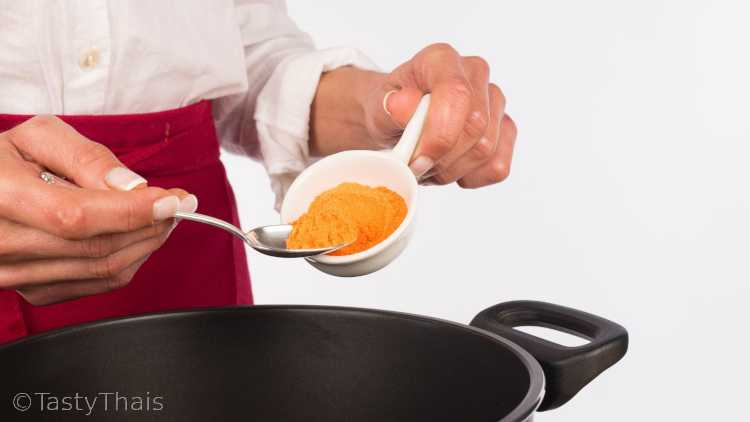
Oyster Sauce
Oyster sauce is a thick and fairly viscous Thai seasoning that is used in many recipes.
Used to add umami to a dish along with a dose of saltiness, oyster sauce is a go-to seasoning for stir-fries and more.
This thick sweet and complex flavored seasoning sauce is actually made by cooking oysters and may contain a number of different ingredients depending on the brand you buy.
It may not be unique to Thai food but you will certainly be looking for it if you are going to be cooking up any number of Thai dishes.
You’ll find this a a bunch of our recipes such as Kale with Shrimp and Beef Namtok
Vegetarian Mushroom Oyster Sauce
To provide an option for vegetarians, oysters are swapped out for mushrooms to make this version of oyster sauce.
It actually tastes somewhat similar though of course you would not expect the taste to be quite the same.
Even so, if you are a vegetarian and want to eat Thai food then vegetarian mushroom oyster sauce is a great substitute to approximate the flavoring that regular oyster sauce brings to a dish.
Vegetable Umami Sauce
Some specialized vegetarian sauces are on the market to provide choice for those who prefer a meat-free diet.
Similar in style to Oyster sauce and soy sauce, they provide the umami taste but the flavor profiles vary wildly so you will need to test and taste to get used to using them in recipes to achieve the taste you want.
Fish Sauce
Fish sauce is an ingredient in almost every Thai savory recipe.
It provides a little umami and a lot of saltiness and is often used to regulate the saltiness of a dish.
This watery sauce has a strong smell before cooking, which some people (maybe most) are not particularly fond of. However, that smell disappears during cooking whilst the flavor infiltrates itself through the other ingredients.
There are several grades of fish sauce and it pays to avoid the cheapest Chinese products and prefer a fish sauce in the medium price range.
The price of premium aged fish sauce can be high and the extra taste it provides probably not sufficiently different to warrant the surcharge.
The difference between the cheap and mid-priced fish sauces WILL make a difference to the taste of your finished dish though.
Check out our famous Pad Thai or Tom Yum Kung recipes for examples.
Vegan Fish Sauce
You can make vegan fish sauce at home as well as buy ready-made products.
Whereas fish sauce is most definitely made from fish, vegan fish sauce is a substitute usually made from mushrooms and seaweed.
Inevitably there is a difference in taste but the finished dish will much more closely resemble the taste profile than omiting the ingredient altogether.
A good investment if you are vegan or vegetarian and do not want to make your own vegan fish sauce substitute.
Golden Mountain Seasoning (Green)
If a Thai recipe calls for seasoning sauce then this is likely what the recipe is referring to.
Golden Mountain is the most common brand of seasoning sauce used in Thailand but we should say that there are tens of different seasonings that could be used.
The green label seasoning is a concoction somewhat similar to soy sauce to add a different flavor profile to a dish and is sold in bottles with green lids.
Golden Mountain Seasoning (Yellow)
The yellow lidded and labeled golden mountain seasoning is not the same as the green label version and is intended to be used at the table although it is sometimes used in Thai dishes.
This premium seasoning is a favorite added to rice, eggs, and fish dishes for added umami flavor and is quite strongly savory tasting.
Maggi Seasoning
Maggi seasoning is very similar to the golden mountain yellow cap seasoning but also used quite frequently as an ingredient in cooked dishes.
It has a strong and savory taste not greatly different from the golden mountain yellow cap but rather stronger-tasting.
Chili Oil
Chili oil is usually made from some type of vegetable oil to which chili, pepper, and various other spices are added.
Some Thai cooks prefer to use a strained oil that is free from particulates and some prefer the oil that comes with chili paste.
This oil adds chili and pepper overtones to a dish and packs quite a hot punch to a dish.
Chili Paste (Nam Prik Pao)
Just as some Thai cooks like to use the strained version of chili oil, from our experience most will use chili paste which is called nam prik pao.
This thick paste is more an oil suspension of dried chili and other spices. If chili oil is desired for a recipe then a teaspoon is simply pressed on top of the paste to let the oil flow in largely free of bits of chili.
No need to get chili oil as well as nam prik pao which you will also use for other recipes too.
Worcestershire Sauce
You will likely be familiar with Worcestershire sauce which is a hot and thin sauce with a particular flavor profile that is made from vinegar, molasses and flavored with fish, onions and a bunch of other seasonings.
This fermented sauce has its roots in India though became popular thanks to Lea & Perrins (a company in Worcester, England) who took the sauce, believed to have been perfected by a retired English Lord who served in India, and marketing it in England from where it based its popularity.
It is now a popular seasoning used in cuisines around the world and is commonly available in Thailand and used in Thai dishes to add taste.
White Vinegar
White refined vinegar is a seasoning added to dishes to give a vinegar sourness.
It is also used as the vinegar base for chili condiments served at the table – especially for adding to soups.
Soy Bean Paste
Made from fermented soybeans and wheat flour that has a sour and very salty taste and viscosity of thick Greek humous.
It is not spicy and used to add flavor to some fish dishes, stir fry, and steamed dishes. Use it sparingly.
Fermented Soybean Sauce
This is a yellow sauce with suspended split and fermented soybeans that is used in a few recipes such as Pad Thai and Tao Jaew Sauce which is a yellow bean sauce dip.
Since it is used for Pad Thai which is a go-to Thai staple dish it is an ingredient you probably want to buy in small quantities.
Pork Seasoning Powder
Pork seasoning powder has become more popular with the decline in the use of MSG.
Knorr is one of the most used brands although there are plenty of others.
If seasoning powder is specified in a recipe without specifying a particular mix then it will be either pork or chicken seasoning powder similar to this.
Pork or chicken depends on your preference.
Chicken Seasoning Powder
See the comments on Pork Seasoning Powder above.
Knorr Chicken Cube
If you do not have time to make stock then a stock cube will give you a basic chicken stock but it is a long way from the same as homemade chicken stock.
If you are making a dish where the stock is not a prominent feature of the dish then using stock cubes is fine.
If you are making ba mee kiew nam where the stock IS the soup then really you need to make your own stock.
Knorr Pork Stock Cube
The comments relating to Chicken stock cubes follow for pork stock which is used for dishes where pork is the main protein and a soup broth is served alongside.
That said it is not unknown to be served with chicken stock soup at a street food joint even if ordering a pork dish – go figure.
Knorr Vegetable Stock Cube
These stock cubes are quite often used to provide a vegetable stock base and it is quite normal to do so since vegetable stock is not usually served to be eaten as is but rather forms the base to which many other ingredients are added and form the main taste.
Knorr Tom Yum Cube
If you can’t be bothered to make a full-blown tom yum broth then you can dissolve one of these in some water.
These are often used as a quick way to make a tom yum tasting broth to pour over dried noodles as a quick snack.
Thai Seasonings Frequently Asked Questions
What seasonings are used in Thai food?
The most common seasonings for Thai food are fish sauce for saltiness, oyster sauce for umami, lime juice or tamarind for sourness, palm sugar for sweetness and seasoning sauces or powders for savory.
What gives Thai food its flavor?
Thai food is carefully balanced food between the main tastes which give it its flavor – sweet, savory, sour, salt, umami and sometimes bitter. Flavor is further developed with chili heat and creaminess often from coconut milk and it is the whole experience which is Thai food.
What spice makes Thai food spicy?
Dried chili along with peppercorns, and ginger give the peppery and chili hot spiciness but many other spices such as cumin, cardamom, curry powder, and many other spices provide more tasteful, less hot spiciness.
What herbs go well with lemongrass?
Thai basil and cilantro/coriander work very well with lemongrass depending on the taste profile you want. Shallots, scallions, spring onion bulbs, and mint are most commonly paired with lemongrass in Thai food.
